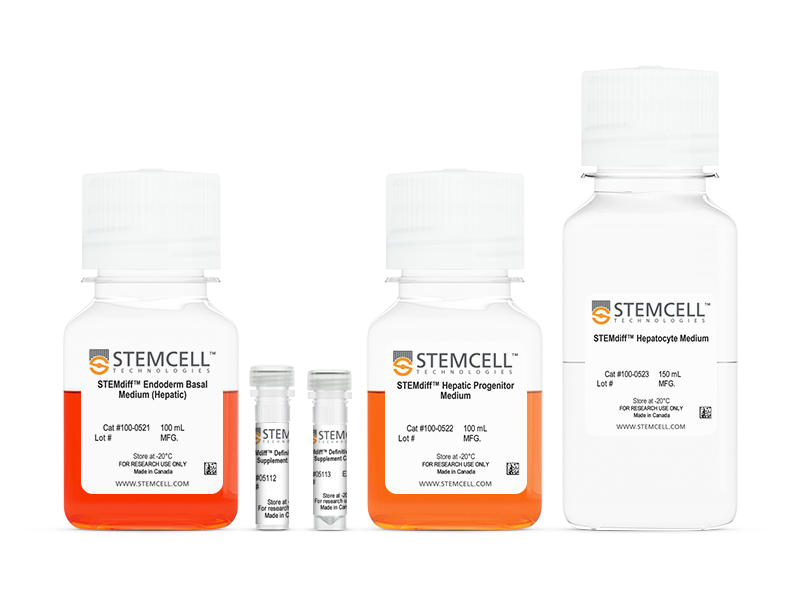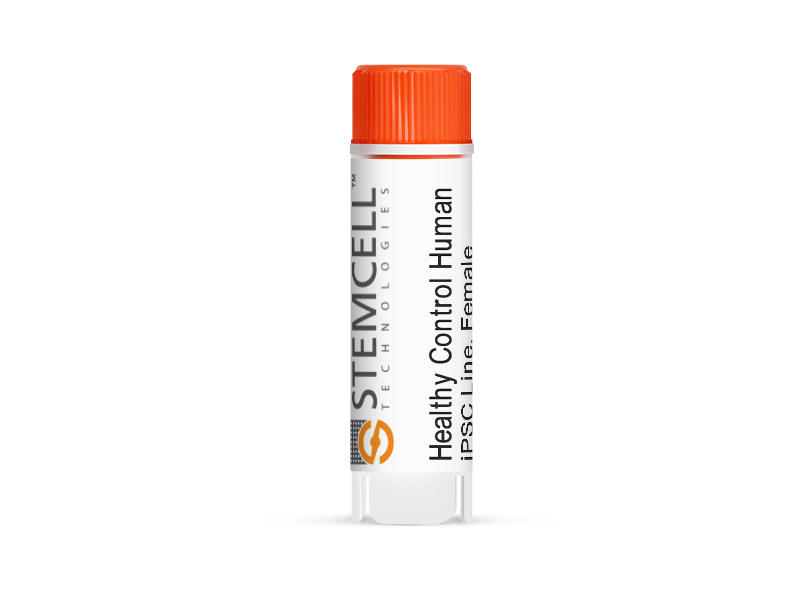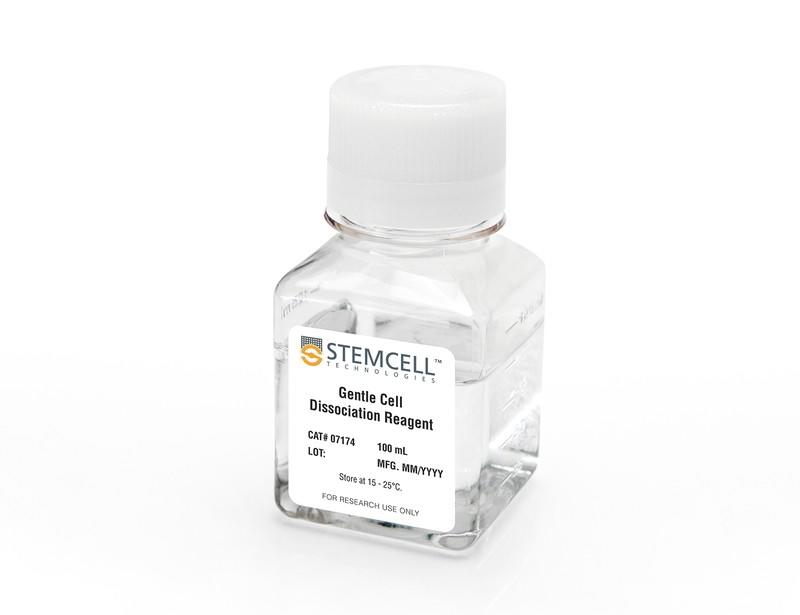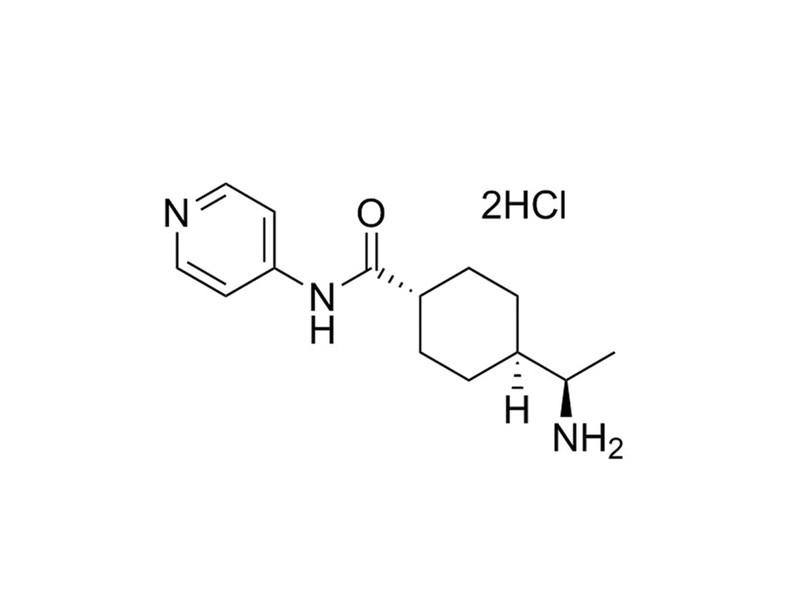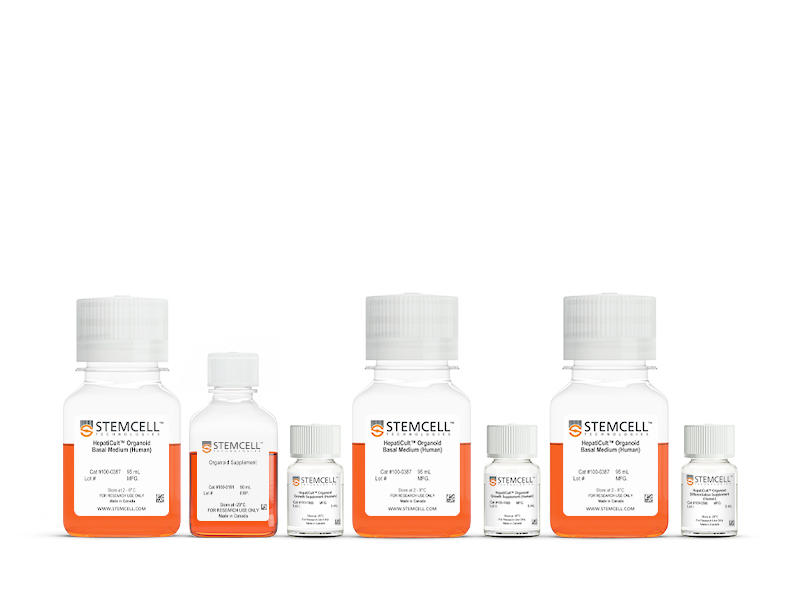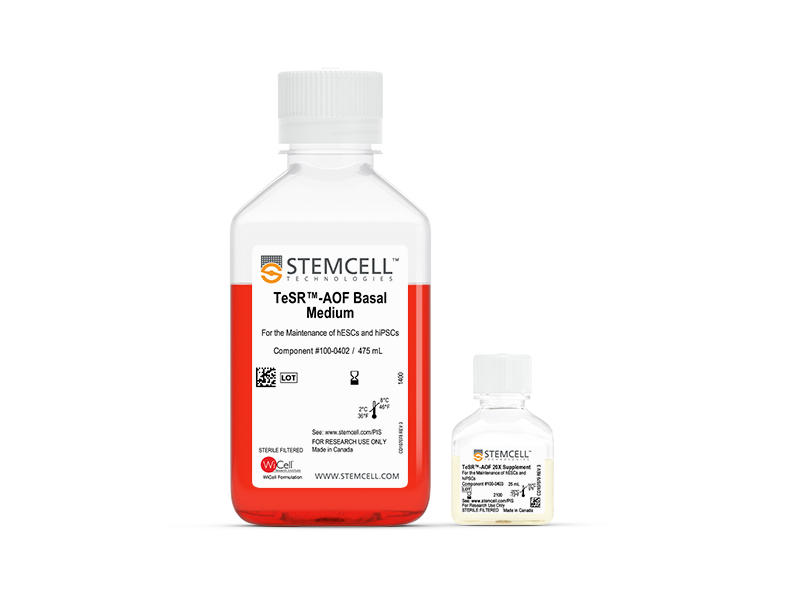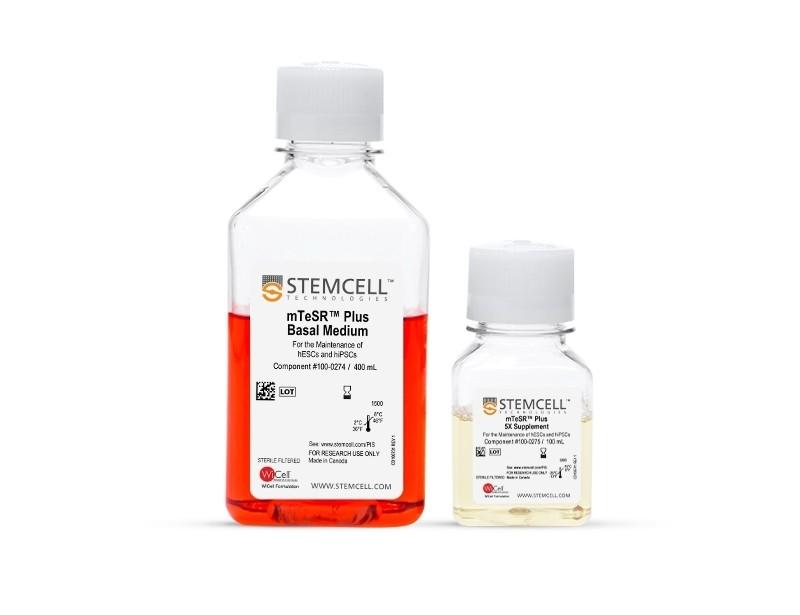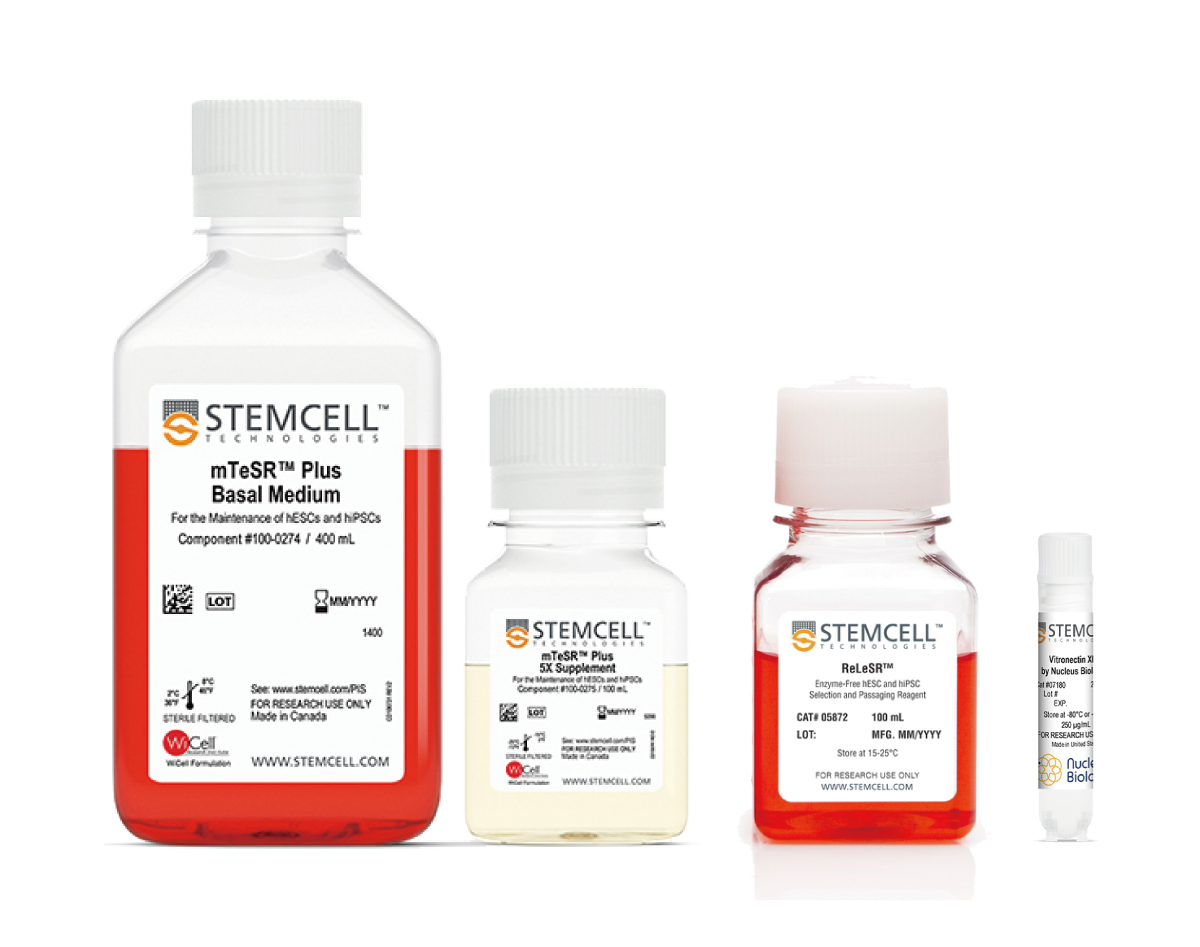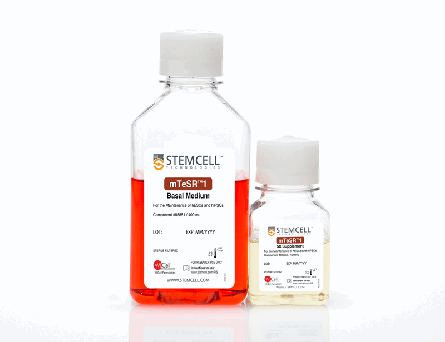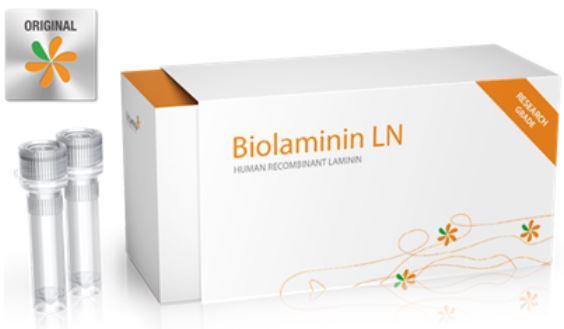STEMCELL Technologies STEMdiff STEMdiff Hepatocyte Kit
- 研究用
- 新製品
STEMdiff™ Hepatocyte Kit(ST-100-0520)は、ヒト多能性幹細胞(hPSC)から、アルブミンやα1-アンチトリプシンを含むいくつかの重要な肝臓特異的マーカーを発現する肝細胞様細胞(hepatocyte-like cells; HLCs)を効率的に作製するキットです。
さまざまなhPSC株を再現性よくHLCに分化できるため、実験用HLCの信頼できる供給源となります。無血清の組成で未定義成分を削減し、実験のばらつきを最小限に抑えることにより、HLC培養物を安定的に分化できます。
本品で作製したHLCは、肝臓研究、疾患モデル、肝毒性試験におけるさまざまな用途に適しています。
製品の特長
STEMdiff™ Hepatocyte Kitで、ヒトES/iPS細胞から肝細胞様細胞(HLC)に無血清で分化
- アルブミンやα1-アンチトリプシン(A1AT)を含む、いくつかの主要な肝臓マーカーを発現するHLCに誘導
- 複数のhPSC株から、特徴的な多角形形態と二核性を有する細胞に再現性良く着実に分化
- 96穴プレートを用いたハイスループットな薬剤毒性および疾患モデルの用途に適切
- HepatiCult™培地を用いた肝オルガノイド作製にも適合するワークフロー
- 変動を最小限に抑える無血清培地
肝細胞様細胞への分化プロトコル
hPSCから胚体内胚葉、肝臓前駆細胞、肝細胞様細胞の3段階を経て、21日間の2次元培養により分化誘導します。
mTeSR™1(ST-85850)、mTeSR™ Plus(ST-100-0276)、TeSR™-AOF(ST-100-0401)で維持したhPSCに適合しています。
Figure 1. Generation of Hepatocyte-Like Cells Within 21 Days Using the STEMdiff™ Hepatocyte Kit
hPSCs are seeded as single cells onto tissue culture-treated plates coated with Laminin-521 in *mTeSR™1, mTeSR™ Plus, or TeSR™-AOF supplemented with 10 µM ROCK inhibitor on day 0. On day 1, differentiation is initiated by replacing the medium with STEMdiff™ Definitive Endoderm (DE) Medium (Stage 1), then daily medium changes are performed. On day 5, cells are either harvested for downstream analyses or cultured for an additional 5 days, with full-medium changes using STEMdiff™ Hepatic Progenitor Medium on days 5, 6, 7, and 9. On day 10, hepatic progenitor cells (HPs) are either harvested for downstream analyses or cultured for an additional 11 days, with full-medium changes using STEMdiff™ Hepatocyte Medium every 2 days. On day 21, hepatocyte-like cells (HLCs) are harvested and used in downstream analyses and assays. hPSCs = Human pluripotent stem cells.
詳細な手順は、製品添付文書をご覧ください。
参考動画:hPSCから肝臓前駆細胞(Day 10)の分化誘導(JoVE Journalのサイトへリンクします)
データ紹介
Figure 2. Cells Undergo Stage-Specific Changes in Expression of Hepatic Markers As Confirmed by Gene Expression Analysis
hPSCs, DE cells, HPs, and HLCs were collected on days 0, 5, 10, and 21, respectively, according to the STEMdiff™ Hepatocyte Kit protocol, and examined for gene expression through qPCR analysis. (A,B) Compared to hPSCs, expression of stem cell marker POU5F1 was down-regulated and expression of DE marker FOXA2 was up-regulated across all three stages of differentiation, demonstrating a successful endodermal lineage specification. (C-F) Up-regulation of hepatic lineage-specific markers AFP, CK19, ALB, and CYP3A4 demonstrates a successful differentiation of hPSCs to HPs and HLCs. Expression levels are normalized to housekeeping genes (ΔCT) and hPSCs for relative expression levels (**** represents an adjusted p-value <0.0001). hES = Human embryonic stem cells; hiPS = Human induced pluripotent stem cells; PHH = Primary human hepatocyte; hPSCs = Human pluripotent stem cells; DE = Definitive endoderm; HPs = Hepatic progenitors; HLCs = Hepatocyte-like cells; AFP = Alpha fetoprotein; CK19 = Cytokeratin 19; ALB = Albumin.
Figure 3. hPSC-derived Hepatic Progenitor Cells and Hepatocyte-Like Cells Express Hepatic Markers As Confirmed by Immunocytochemistry Analysis
Cells cultured to day 10 (HPs) and day 21 (HLCs) were fixed with 4% paraformaldehyde and permeabilized before being stained with primary and secondary antibodies. (A-C) HPs expressed the epithelial marker EPCAM, ductal marker CK19, fetal serum protein AFP, the hepatic transcription factors HNF6 and HNF4a, and the stage-specific transcription factor TBX3. (C) By day 10, some of the HPs also began to express the mature serum protein albumin. (D-F) Most HLCs expressed the mature hepatic markers ALB, CYP3A4, and A1AT by day 21. HPs = Hepatic progenitors; HLCs = Hepatocyte-like cells; CK19 = Cytokeratin 19; AFP = Alpha fetoprotein; ALB = Albumin.
Figure 4. STEMdiff™ Hepatocyte Kit Supports Efficient Differentiation of hES and hiPS Cells to Hepatocyte-Like Cells
hES (H9 and H1) cells and hiPS (WLS-1C) cells were cultured for 21 days using the STEMdiff™ Hepatocyte Kit. At the end of the culture period, cells were harvested and analyzed by flow cytometry for expression of hepatocyte markers ALB and A1AT. (A) Percentages and (B) total numbers of cells expressing ALB and A1AT following differentiation of hES or hiPS cells are shown. > 60% of HLCs are ALB+/A1AT+ at day 21 of the differentiation process. hES = Human embryonic stem cells; hiPS = Human induced pluripotent stem cells; ALB = Albumin; HLCs = Hepatocyte-like cells.
Figure 5. hPSC-Derived HLCs Exhibit Key Liver Functionalities
Upon maturation of HPs to HLCs, the cells acquired the ability to (A) synthesize and secrete serum protein albumin (n=11), as detected by ELISA (Abcam Catalog #ab108788), (B) and exhibited CYP3A4 enzymatic activity (n=15), as assessed using the P450-GloTM CYP3A4 Assay (Promega Catalog #V9002). (C) Day 21 HLCs were also capable of producing bile acids (n=2) (D) and synthesizing and secreting urea (n=2) at levels comparable to primary human hepatocytes (PHH; n=3), as detected by colorimetric assays (Abcam Catalog #ab239702, ab83362, respectively). Error bars = SD. Ordinary one-way ANOVA used for statistical testing (*** represents an adjusted p-value of 0.0007, ** represents an adjusted p-value of 0.0011, * represents an adjusted p-value of 0.0179, ns = not significant). HPs = Hepatic progenitors; HLCs = Hepatocyte-like cells; PHH = Primary human hepatocyte.
Figure 6. HLCs are More Sensitive Models of Drug-Induced Toxicity than Immortalized Cell Line HepG2
HLCs and HepG2 cells cultured in 96-well plates were treated with (A) ketoconazole, (B) rifampicin, a 0.1% DMSO vehicle control (DMSO Ctrl), or 1 μM staurosporine (Sts Ctrl) for 72 hours. Full-medium changes with fresh compound volumes were performed for the HLCs on day 18 and day 20, and analyses were performed on day 21, 24 hours after the final compound addition. Cell viability for both treated and untreated (No treatment) HLCs and HepG2 cells was assessed using the CellTiter-Glo® 3D Cell Viability Assay (Promega Catalog #G9681). HLCs exhibited ketoconazole-induced hepatotoxicity (IC50 for 1C-derived HLCs = 20.57 μM, IC50 for H9-derived HLCs = 23.79 μM) at a lower dose than HepG2 cells (IC50 = 37.74 μM). Similarly, HLCs were able to capture rifampicin-induced hepatotoxicity (IC50 for 1C-derived HLCs = 120.4 μM, IC50 for H1-derived HLCs = 197.4 μM) at a lower dose than HepG2 cells (IC50 = 332.3 μM). Error bars = SD. HLCs = Hepatocyte-like cells.
hPSC由来 肝臓オルガノイドの作製
STEMdiff™ Hepatocyte Kitで分化誘導した肝前駆細胞(HP)または肝細胞様細胞(HLC)から、HepatiCult™ Organoid Growth Medium (Human)(HepatiCult™ Organoid Kitの構成品)を使用して肝オルガノイドを作製できます。
プロトコールはこちら>>(STEMCELL Technologies社のサイトへリンクします)
Figure 7. HP- and HLC-derived Liver Organoids Can Be Reliably Generated Using HepatiCult™ Organoid Kit
hPSC-derived liver organoids can be established from cells generated using the STEMdiff™ Hepatocyte Kit. HPs and HLCs were collected on days 10 and 21 of differentiation, respectively, seeded into Corning® Matrigel® domes, and grown using the HepatiCult™ Organoid Kit. Shown are representative images of HP- and HLC-derived organoids at passage 2, which were (A,B) established and expanded using HepatiCult™ Organoid Growth Medium (Human; hOGM) and then (C,D) further differentiated using HepatiCult™ Organoid Differentiation Medium (Human; hODM). hPSC = human pluripotent stem cells; HPs = Hepatic progenitors; HLCs = Hepatocyte-like cells.
Figure 8. HP- and HLC-derived Hepatic Organoids Exhibit Gene Expression Consistent with Hepatic Maturation When Differentiated Using hODM
hPSC-derived liver organoids were established, expanded for up to 10 passages, differentiated, and harvested for gene expression analysis through qPCR at each passage. Compared to two-dimensional cultures of HPs and HLCs collected on day 10 and day 21 of differentiation, respectively, three-dimensional organoid cultures established from these stages and further matured in hODM exhibited up-regulated expression of mature hepatic markers ALB, ASGR1, and CYP3A4 at levels comparable to PHH. Expression levels are normalized to housekeeping genes (**** represents an adjusted p-value <0.0001, ** represents an adjusted p-value of 0.0035, * represents an adjusted p-value of 0.0397). hPSC = human pluripotent stem cells; HPs = Hepatic progenitors; HLCs = Hepatocyte-like cells; ALB = Albumin; PHH = Primary human hepatocyte.

